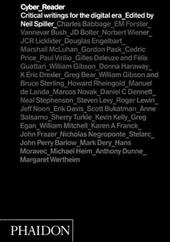
|
Cyber Reader: Critical Writings for the Digital Era
Hardback
Main Details
| Title |
Cyber Reader: Critical Writings for the Digital Era
|
| Authors and Contributors |
Edited by Neil Spiller
|
| Physical Properties |
| Format:Hardback | | Pages:320 | | Dimensions(mm): Height 245,Width 172 |
|
| Category/Genre | Ethical and social aspects of computing
Internet guides and online services |
|---|
| ISBN/Barcode |
9780714840710
|
| Classifications | Dewey:303.4834 |
|---|
| Audience | |
|---|
|
Publishing Details |
| Publisher |
Phaidon Press Ltd
|
| Imprint |
Phaidon Press Ltd
|
| Publication Date |
19 March 2002 |
| Publication Country |
United Kingdom
|
Description
This text is an introduction to key texts related to the theme of cyberspace - the virtual communicative space created by digital technologies - offering the reader an overview of cyberspace theories through extracts of some of the best writings of this wide-ranging subject. Cyberspace culture is itself cross-disciplinary: this book includes texts from a variety of fields concerned with cyberspace - science, complexity theory, philosophy and metaphysics, sexual politics, art and architecture as well as science fiction - illustrating how these different disciplines inform one another, providing an illuminating and original collection of key extracts from books and essays on the subject. The extracts are presented in chronological order, beginning with some precursors to cyberspace theory as we know it today. Extracts by early theoreticians such as Charles Babbage or Alan Turing, or writers such as E.M. Forster help to give a historical perspective to the subject. Each extract is prefaced by a short introduction that contextualizes the piece, explains the key themes and terms alluded to in the extract, and cross-refers it to other texts in the book. This text is an informative guide to cyberspace culture and should be an excellent intrduction for students working within the disciplines covered in the book.
Author Biography
Neil Spiller is Reader of Architecture and Digital Theory at the Bartlett School of Architecture, University College, London. He has already published architectural titles related to cyberspace - Digital Dreams: Architecture and the new Alchemic Technologies (Ellipsis, London, 1998/WW Norton, US) and two issues of Architectural Design magazine, 'Architects in Cyberspace I and II' - as well as a monograph on his own architecture and writings Maverick Deviations: Architectural Works 1985-98 (Wiley-Academy, London, 2000). Author's Residence: London SW 18
Reviews' - serves as an excellent introduction to the potentially alienating and over-mystified world of virtual reality. - this book presents what may be considered as the emerging classic texts that offer the reader a grounding in this ungrounded subject. The work is not aimed at a purely architectural audience. In drawing from familiar texts such as William Gibson's 'Neuroamancer', and more surprising contributions such as the EM Forster extract from 'The Machine Stops', it approaches the subject from a variety of fields and introduces more weighty non-fiction themes such as scientific discovery, philosophy, metaphysics and gender politics. It is a very easy book to read; each of the extracts are accompanied by a preface by Spiller that provides helpful cross-references between the chronological extracts.' (Building Design) 'Spiller says: 'This book introduces the principal characters and concepts, providing a framework into which to place further ideas and discoveries.' It is exactly that.' (Architects' Journal) 'Spiller's compilation of contemporary and historical texts plots the emergence of the cyber-imagination in literature and fiction. The book could easily have fallen into the minefield of obfuscation that so often dogs attempts to encapsulate hip critical concepts, but happily it does the exact opposite, delineating its surprisingly extended lineage in the history of ideas, while throwing helpful light on to its inner complexities. - After reading this excellent anthology, you will either ditch your PC - gateway to the infinity that is cyberspace - or buy a hundred more and disappear up your own hard drive.' (Modern Painters) ' even wearing cybernetician's hat I find Spiller's Cyber Reader fascinating - [his] commentary if one of the most interesting aspects of this book - Spiller's selection is quite wonderful. His book is remarkable: for the individual items in it, and for their articulated collection together.' Ranulph Glanville, Architectural Design, 2004
|